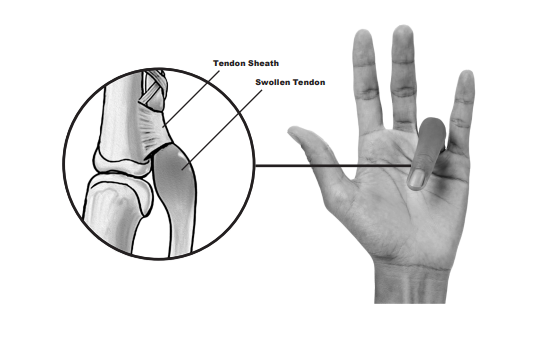Trigger finger/thumb
To view this page as a pdf; click here.
What is Trigger Finger / Thumb?
It is a condition in which the finger or thumb locks or clicks into a bent position in the palm. This is often painful and can occur at any time. It is more common in women over the age of 40.
What causes it?
A thickening and swelling of the tendon tunnel (sheath) causes the tendon to catch and trigger. In most people, triggering occurs for no apparent reason. It is more common in people with diabetes and rheumatoid arthritis. It can occur after injury to the finger. The condition may be aggravated by work based activities along with hobbies and sports.

What Treatments are available to treat Trigger Finger/Thumb?
In mild cases the condition may resolve in a couple of weeks.
1. Self-Management Strategies:
- Try to avoid activities that provoke the pain. This is not always easy as you need your hands for most activities.
- Trying strapping your finger to the neighbouring finger. This acts as a splint, and can sometimes help. This is not possible for the thumb.
- The finger can be splinted into a straight position to prevent it from bending. This may need to be worn for several weeks. This works best at night if you wake in the morning and your finger is stuck in a bent position. You will need to be referred for this.
- Anti-inflammatory/pain relief medications. However, check with your GP or Pharmacist if you are on any other medications.
- Kinesiotaping. This is a tape which can be used to help the body’s natural healing process. There are video links online to demonstrate various taping techniques to help with this condition. You may need to try several to see which works best for you.
- A suggestion can be found at the bottom of this page.
2. Other treatments that your Doctor may recommend:
if your self-management approach does not help your symptoms and you find that everyday activitiess are still being affected, then the following treatments may be considered by your doctor.
a) Steroid Injection A corticosteroid injection combined with anaesthetic is helpful in approximately 50-80 percent of cases to reduce the swelling and allow the tendom to move freely. They are less successful with patients who have conditions such as diabetes and rheumatoid arthritis.
There are very small risks involved which will be discussed prior to the procedure being undertaken. It may take some time for the injection to work, with a second injection considered if the effect wears off. This is generally less effective than the first.
b) Surgery
When symptoms are severe or do not improve with the other treatments, then an operation may be needed. This is called a Trigger Finger/Thumb Release.
This is usually performed as a day case which means you will go home the same day as your operation. This is usually done under a local anaesthetic, meaning you are not put to sleep. The operation involves the roof of the tendon tunnel being released, taking the pressure off the tendon. It usually takes 10-14 days for the wound to heal.
You will be encouraged to keep your fingers or thumb moving within the dressing to help reduce any swelling or stiffness, and undertake light activity such as eating or dressing. Further information on the procedure will be provided by the specialist if this is the option of choice
Rydym yn croesawu gohebiaeth a galwadau ffôn yn y Gymraeg neu'r Saesneg. Atebir gohebiaeth Gymraeg yn y Gymraeg, ac ni fydd hyn yn arwain at oedi. Mae’r dudalen hon ar gael yn Gymraeg drwy bwyso’r botwm ar y dde ar frig y dudalen.
We welcome correspondence and telephone calls in Welsh or English. Welsh language correspondence will be replied to in Welsh, and this will not lead to a delay. This page is available in Welsh by clicking ‘Cymraeg’ at the top right of this page.